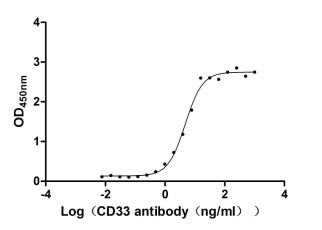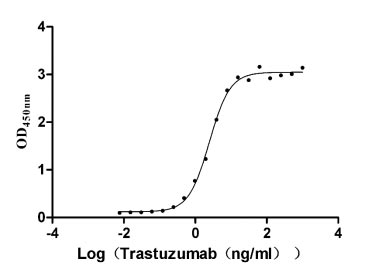Recombinant Mouse CD9 antigen (Cd9), partial
-
货号:CSB-YP004969MO1
-
规格:
-
来源:Yeast
-
其他:
-
货号:CSB-EP004969MO1
-
规格:
-
来源:E.coli
-
其他:
-
货号:CSB-EP004969MO1-B
-
规格:
-
来源:E.coli
-
共轭:Avi-tag Biotinylated
E. coli biotin ligase (BirA) is highly specific in covalently attaching biotin to the 15 amino acid AviTag peptide. This recombinant protein was biotinylated in vivo by AviTag-BirA technology, which method is BriA catalyzes amide linkage between the biotin and the specific lysine of the AviTag.
-
其他:
-
货号:CSB-BP004969MO1
-
规格:
-
来源:Baculovirus
-
其他:
-
货号:CSB-MP004969MO1
-
规格:
-
来源:Mammalian cell
-
其他:
产品详情
-
纯度:>85% (SDS-PAGE)
-
基因名:
-
Uniprot No.:
-
别名:Cd9; CD9 antigen; CD antigen CD9
-
种属:Mus musculus (Mouse)
-
蛋白长度:Partial
-
蛋白标签:Tag type will be determined during the manufacturing process.
The tag type will be determined during production process. If you have specified tag type, please tell us and we will develop the specified tag preferentially. -
产品提供形式:Lyophilized powder
Note: We will preferentially ship the format that we have in stock, however, if you have any special requirement for the format, please remark your requirement when placing the order, we will prepare according to your demand. -
复溶:We recommend that this vial be briefly centrifuged prior to opening to bring the contents to the bottom. Please reconstitute protein in deionized sterile water to a concentration of 0.1-1.0 mg/mL.We recommend to add 5-50% of glycerol (final concentration) and aliquot for long-term storage at -20℃/-80℃. Our default final concentration of glycerol is 50%. Customers could use it as reference.
-
储存条件:Store at -20°C/-80°C upon receipt, aliquoting is necessary for mutiple use. Avoid repeated freeze-thaw cycles.
-
保质期:The shelf life is related to many factors, storage state, buffer ingredients, storage temperature and the stability of the protein itself.
Generally, the shelf life of liquid form is 6 months at -20°C/-80°C. The shelf life of lyophilized form is 12 months at -20°C/-80°C. -
货期:Delivery time may differ from different purchasing way or location, please kindly consult your local distributors for specific delivery time.Note: All of our proteins are default shipped with normal blue ice packs, if you request to ship with dry ice, please communicate with us in advance and extra fees will be charged.
-
注意事项:Repeated freezing and thawing is not recommended. Store working aliquots at 4°C for up to one week.
-
Datasheet :Please contact us to get it.
相关产品
靶点详情
-
功能:Integral membrane protein associated with integrins, which regulates different processes, such as sperm-egg fusion, platelet activation and aggregation, and cell adhesion. Present at the cell surface of oocytes and plays a key role in sperm-egg fusion, possibly by organizing multiprotein complexes and the morphology of the membrane required for the fusion. In myoblasts, associates with CD81 and PTGFRN and inhibits myotube fusion during muscle regeneration. In macrophages, associates with CD9 and beta-1 and beta-2 integrins, and prevents macrophage fusion into multinucleated giant cells specialized in ingesting complement-opsonized large particles. Also prevents the fusion between mononuclear cell progenitors into osteoclasts in charge of bone resorption. Acts as a receptor for PSG17. Involved in platelet activation and aggregation. Regulates paranodal junction formation. Involved in cell adhesion, cell motility and tumor metastasis. Also regulates integrin-dependent migration of macrophages, particularly relevant for inflammatory response in the lung.
-
基因功能参考文献:
- The Cd9(-/-) and Cd9(-/-) Cd81(-/-) deletions are associated with a decreased microvilli density on the MII oocyte surface. Microvilli thickness is significantly increased whatever the deleted tetraspanin gene be. Only Cd9 deletion clearly disturbs the vesicular traffic, increasing the number of clathrin and exosome vesicles. PMID: 27879451
- CD9 regulates the T cell-stimulatory capacity of granulocyte-macrophage colony-stimulating factor (GM-CSF)-dependent bone marrow-derived Dendritic Cells (BMDCs), without affecting antigen presentation by fms-like tyrosine kinase 3 ligand (Flt3L)-dependent BMDCs. PMID: 28533221
- DPP4:CD9:TTSP as the protein complexes are necessary for early efficient MERS-coronavirus entry. PMID: 28759649
- Our results indicate that the suppression of cartilage degradation in CD9(-/-) could be in part related to an increase in the expression of the two main cartilage extracellular matrix proteins aggrecan and type II collagen. PMID: 27784871
- upregulation may play an important role in podocyte morphology, adhesion, and migration PMID: 25503725
- Tetraspanin CD9 and ectonucleotidase CD73 identify an osteochondroprogenitor population with elevated osteogenic properties. PMID: 25564652
- Data indicate that anti-inflammatory effects of statins are CD9-dependent. PMID: 24040034
- study demonstrates ablation of Cd9 had no detectable effect on de novo primary proatate tumour onset, but did significantly increase metastasis to the liver but not the lungs PMID: 23575960
- chemotaxis toward antigen is controlled in mast cells by a cross-talk among FcepsilonRI, tetraspanin CD9, transmembrane adaptor proteins NTAL and LAT, and cytoskeleton-regulatory proteins of the ERM family PMID: 23443658
- tetraspanin CD9 modulates molecular organization of integrins in lymphatic endothelial cells, thereby supporting several functions required for lymphangiogenesis PMID: 23223239
- Tetraspanin family member CD9 plays an important role in sperm-egg fusion. PMID: 22609062
- Results show that SSCs are the most concentrated in CD9(+)EPCAM(low/-) population and also suggest that EPCAM plays an important role in progenitor cell amplification in the mouse spermatogenic system. PMID: 21858196
- Our study demonstrated the importance of CD9 in wound re-epithelialization, linking this molecule directly to basement membrane formation and epidermal migration through participating in the regulation of the JNK/MMP-9 pathway. PMID: 21881583
- propose that sperm-egg fusion is a direct consequence of CD9 controlled sperm-egg adhesion properties. CD9 generates adhesion sites responsible for the strongest of the observed gamete interaction. PMID: 21690351
- knockout mice display abnormal adult angiogenesis PMID: 20592186
- This study characterizes CD9 in sperm development and fertilization. PMID: 20428892
- Data show that B16F1 lones stably overexpressing CD9 had reduced ability to form colonies in soft agar PMID: 19777564
- CD9 is identified as the first receptor for a murine PSG /glycoprotein 17/ PMID: 11805154
- role of CD9 in the strengthening of fertilin beta-mediated cell adhesion PMID: 11906941
- CD9 may play a role in LIF-mediated maintenance of undifferentiated ES cells. PMID: 11950938
- CD9 down-regulation may be a sensitive indicator of macrophage differentiation PMID: 12056820
- CD9 inhibits SMC migration by a stimulation of both stress fiber formation and integrin clustering, leading to a stimulation of FAK phosphorylation. PMID: 12083484
- the function of CD9 in sperm-egg fusion is was analyzed in CD9-deficient mouse eggs PMID: 12086470
- CD9 was enriched in myelinating oligodendrocytes and myelin internodes. Immunoprecipitation of CD9 from postnatal rat cerebrum coprecipitated beta1 integrin, CD81, and Tspan-2. PMID: 12420314
- CD9 is found with with the alpha6beta1 integrin heterodimer in parietal endoderm cells , suggesting a role for CD9 in alpha6beta1 mediated migration of parietal endoderm. PMID: 12745436
- CD9 is localized to paranodes and has a role in regulating paranodal junctional formation. PMID: 14715942
- CD9 is dispensable for B cell development and humoral immunity. PMID: 16116178
- During oogenesis the development of the ability of the oolemma to fuse with sperm may be regulated by synthesis of CD9 by the oocyte. PMID: 16719947
- Taken together, these results suggest that CD9 expressed on osteoclast lineage cells might positively regulate osteoclastogenesis via the regulation of p44/42 MAPK activity. PMID: 16808899
- CD9 expression by multiple myeloma cells is upregulated in vivo by close interaction of the cells with endothelial cells and CD9 is involved in transendothelial invasion PMID: 16900214
- CD9 was differentially expressed in uterus depending on the stage of implantation & was upregulated in ovarian steroid hormone-dependent manner, implicating multiple roles of CD9 in regulation of embryo implantation during the peri-implantation period. PMID: 17126340
- Oocyte CD9 is enriched on the microvillar membrane and required for normal microvillar shape and distribution. PMID: 17239847
- The expression levels of both CD9 mRNA and protein in the frozen oocytes were significantly lower than those found in the fresh oocytes. PMID: 17307168
- establish for the first time a role for CD9 in the tumorigenic process PMID: 17582603
- The fusion-facilitating activity of CD9-containing vesicles by examining the fusion of sperm to CD9(-/-) eggs with the aid of exogenous CD9-containing vesicles, is investigated. PMID: 18728192
- Immunoglobulin superfamily member IgSF8 (EWI-2) and CD9 in fertilisation: evidence of distinct functions for CD9 and a CD9-associated protein in mammalian sperm-egg interaction. PMID: 19210920
- macrophage CD9 negatively regulates LPS response at lipid-enriched membrane microdomains PMID: 19414803
显示更多
收起更多
-
亚细胞定位:Cell membrane; Multi-pass membrane protein. Membrane; Multi-pass membrane protein. Secreted, extracellular exosome.
-
蛋白家族:Tetraspanin (TM4SF) family
-
组织特异性:Expressed predominantly in the peripheral nervous system. Highly expressed in oocytes and blastocysts (at protein level). Expression is also observed on follicular oocytes in the ovary, whereas no expression is found on follicular cells (at protein level)
-
数据库链接:
KEGG: mmu:12527
STRING: 10090.ENSMUSP00000032492
UniGene: Mm.210676
Most popular with customers
-
Recombinant Human Myeloid cell surface antigen CD33 (CD33), partial (Active)
Express system: Mammalian cell
Species: Homo sapiens (Human)
-
Recombinant Human Lymphotoxin-alpha (LTA) (Active)
Express system: Mammalian cell
Species: Homo sapiens (Human)
-
Recombinant Human Receptor tyrosine-protein kinase erbB-2 (ERBB2), partial (Active)
Express system: Mammalian cell
Species: Homo sapiens (Human)
-
Recombinant Human Intestinal-type alkaline phosphatase (ALPI) (Active)
Express system: Mammalian cell
Species: Homo sapiens (Human)
-
Recombinant Macaca mulatta Semaphorin-4D isoform 1 (SEMA4D), partial (Active)
Express system: Mammalian cell
Species: Macaca mulatta (Rhesus macaque)
-
Recombinant Human Lymphocyte antigen 6 complex locus protein G6d (LY6G6D) (Active)
Express system: Yeast
Species: Homo sapiens (Human)
-
Recombinant Human Glucagon-like peptide 1 receptor (GLP1R), partial (Active)
Express system: Mammalian cell
Species: Homo sapiens (Human)
-
Recombinant Human Desmoglein-3 (DSG3), partial (Active)
Express system: Baculovirus
Species: Homo sapiens (Human)




















